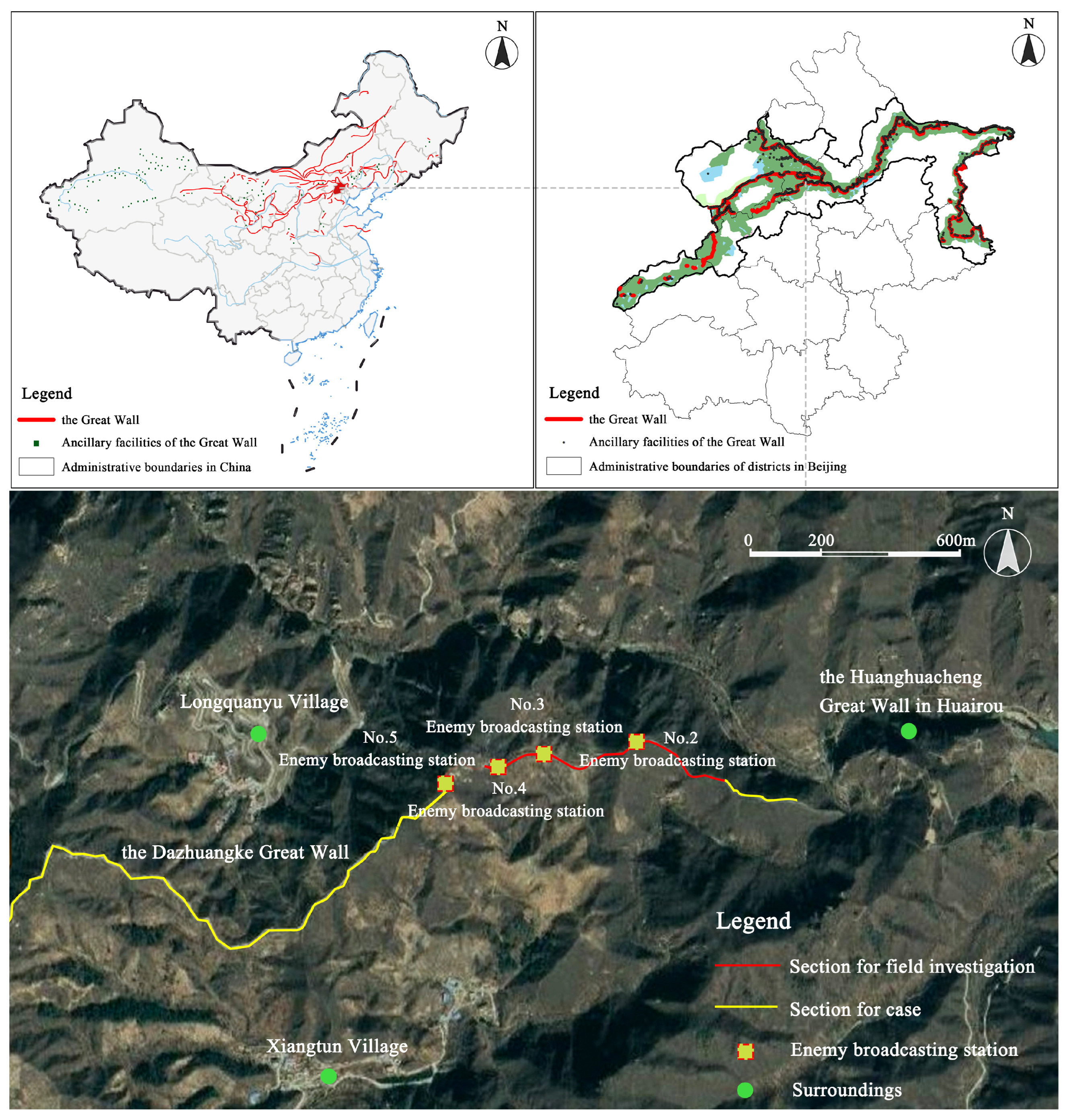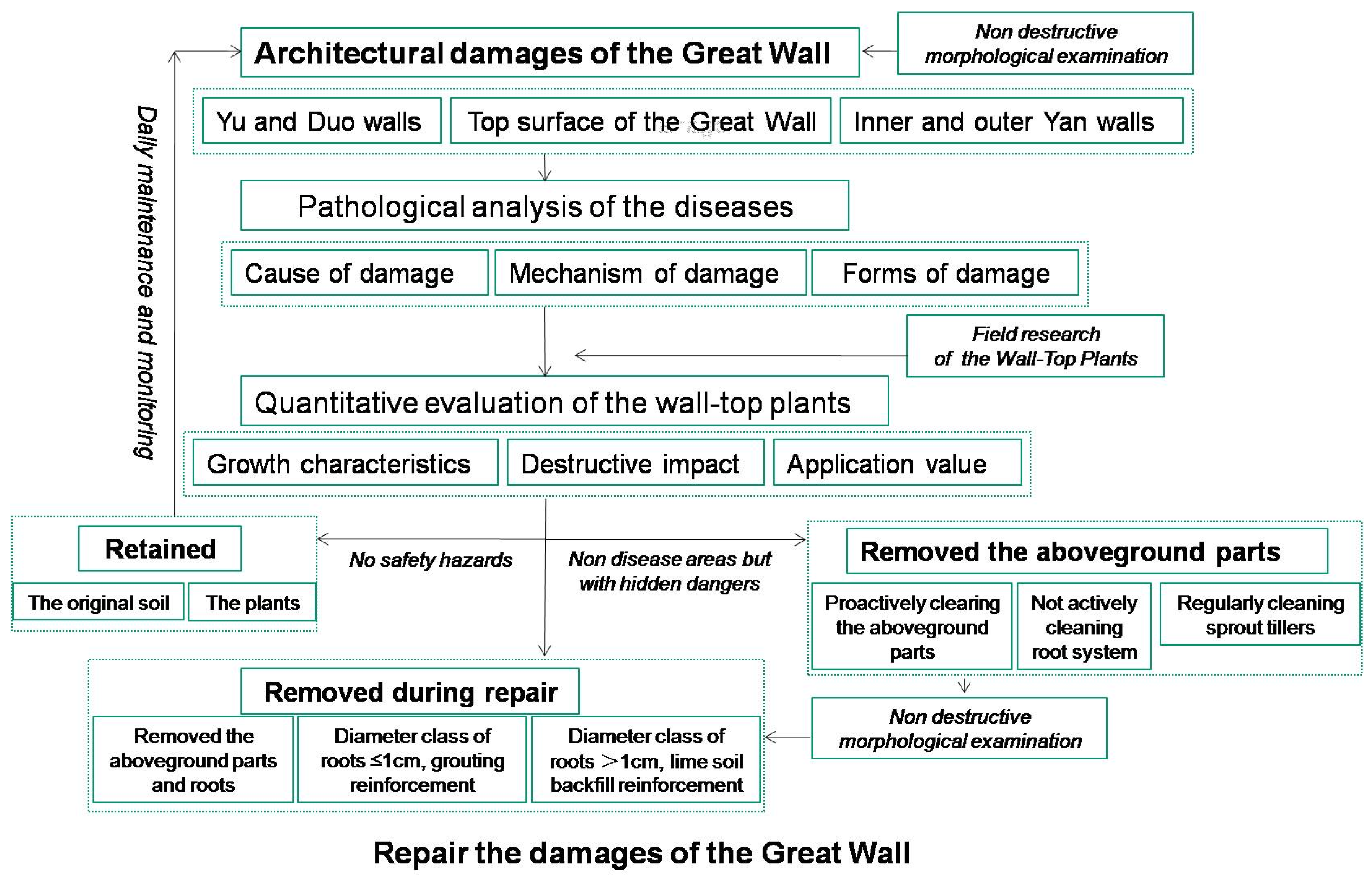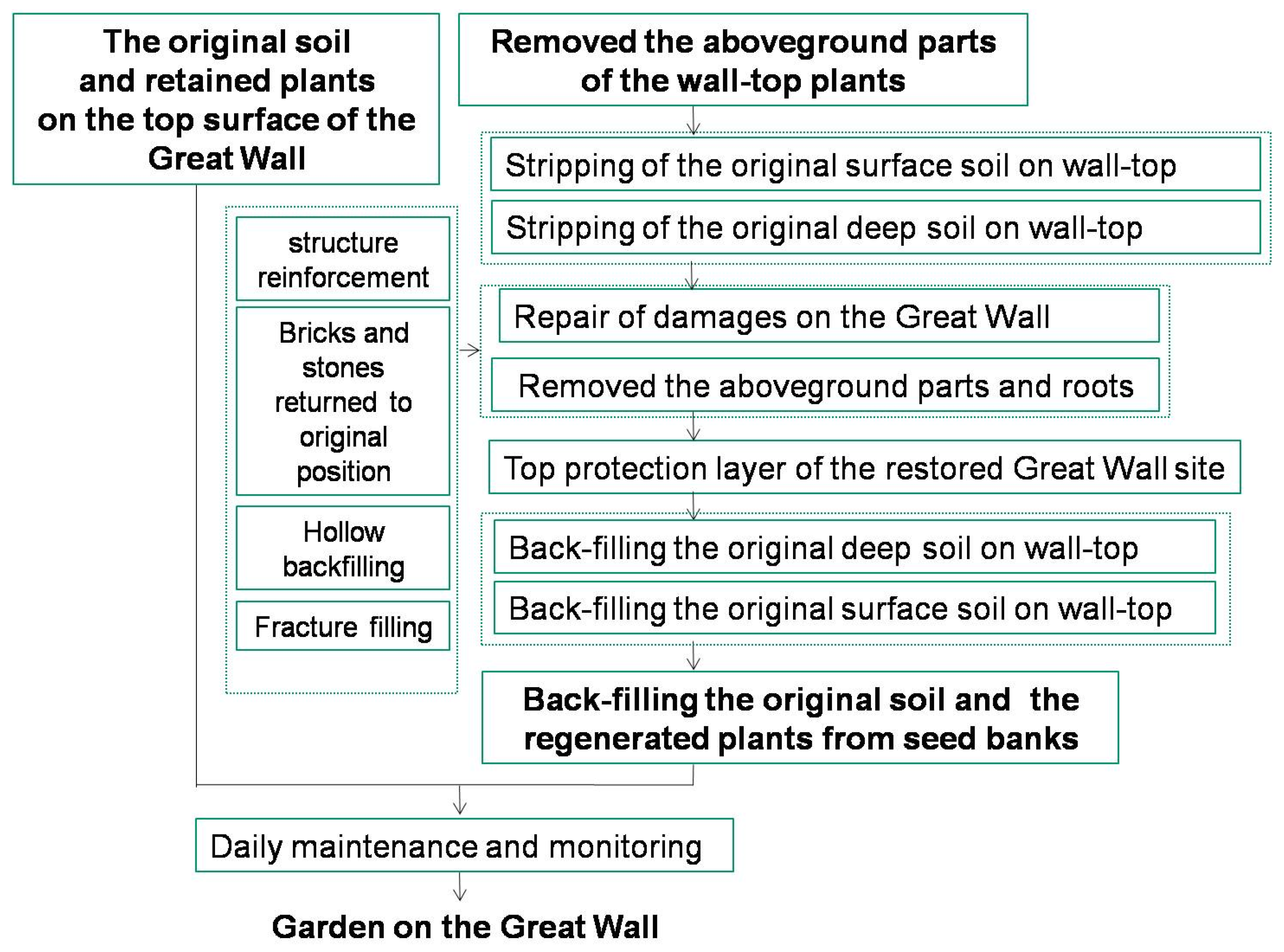Garden on the Great Wall—A Sustainable Solution for the Plants on the Top Surface of the Great Wall Heritage Site
Abstract
1. Introduction
2. Overview of the Great Wall of China
2.1. The Beijing Great Wall and Its Construction Method
2.2. Species and Distribution Characteristics of Wall-Top Plants
2.3. Architectural Damage to the Great Wall Caused by the Growth of Wall-Top Plants
3. Disposal Results of Wall-Top Plants
3.1. Quantitative Evaluation of Wall-Top Plants
3.2. The Disposal Framework of the Remaining Root Systems of Wall-Top Plants
- Wall-top plants in areas of architectural damage should be removed, and all remaining root systems within the Great Wall’s structure should be thoroughly cleared during the repair of architectural damage. If cracks or cavities exist in the cleared root system area, injection grouting should be used to reinforce areas with diameters below 1 cm, while areas with diameters above 1 cm should be back-filled with lime soil and compacted.
- For wall-top plants, which are not located in areas of architectural damage but pose a threat to the structural safety of the Great Wall, the aboveground parts should be removed, but the remaining root systems should not be cleared. During the seasonal maintenance period in the summer and autumn, the decayed parts of remaining root systems and possible sprout tillers should be cleared until the plant and roots have completely died off (the method of injection grouting and lime soil filling for cavities within the Great Wall’s structure formed by the original root system is the same as mentioned above).
- The remaining root systems of dead wall-top plants, which are not located in areas of architectural damage, should be gradually cleared as they decay. During the seasonal maintenance period in the spring and autumn, the decayed portions of root systems should be cleared, and the cavities should be filled with lime soil and compacted (the technical requirements are the same as those mentioned above).
4. Discussion of the ‘Soft Capping’ Protection System
5. Implementation Recommendations
- The structure of the Great Wall of Beijing, the climate and climate change of the natural surroundings, the micro-environment on the top surface, have certain unique characteristics. These are fundamental factors for the existence of plants on the top surface. These factors also mean that the disposal technology for this type of plant does not have universal characteristics. The interpretation and management of the relationship between the types of damage affecting the Great Wall in Beijing and the plants on its top surface should therefore be carried out by professional technical personnel.
- Before making a decision on whether to remove or preserve wall-top plants, a thorough on-site investigation should be conducted to accurately identify the types and spatial distribution characteristics of wall-top plants. Based on comprehensive research by experts in Great Wall architectural damage, quantitative evaluation methods should be used to determine the specific plant species and categories to be removed or preserved.
- Only wall-top plants, which are a direct cause of architectural damage, should be removed. Along with removal of the plants, thorough restoration of the Great Wall’s architectural damage should be carried out. The technology for disposal of the remaining root systems of wall-top plants also requires more practical testing and further research.
- It is theoretically feasible to protect the Great Wall using the original soil cover from the top surface and reserved plants, back-filling of the original soil cover and regeneration of wall-top plants from seed banks to form ‘soft capping’; however, testing and practical verification are still required. The key technical links involved in this process need to be supported by scientific evidence. The protection mechanism of this ‘soft capping’ technology also needs to be further developed.
- The construction of the Garden on the Great Wall and the Great Wall cultural landscape takes the Great Wall itself as a subject and a carrier, with the preserved and regenerated wall-top plants as a key component. It also includes the natural plants and the ecosystem in the Great Heritage Environment area where the Great Wall is located.
Author Contributions
Funding
Institutional Review Board Statement
Informed Consent Statement
Data Availability Statement
Acknowledgments
Conflicts of Interest
References
- Shen, Y.; Su, Q.; Jia, T.; Zhou, X. Characteristics of the site selection and the layout of the Great Wall of the Ming dynasty from a military perspective: Xiaohekou section as an example. Front. Archit. Res. 2020, 9, 541–555. [Google Scholar] [CrossRef]
- Chen, T.; Wang, L.; Ren, J. Research on the Cultural Heritage Value of the Great Wall. Chin. Cult. Herit. 2018, 3, 4–14. (In Chinese) [Google Scholar]
- Zhang, Y.K.; Li, S.Y.; Tan, L.F.; Zhou, J.Y. Distribution and Integration of Military Settlements’ Cultural Heritage in the Large Pass City of the Great Wall in the Ming Dynasty: A Case Study of Juyong Pass Defense Area. Sustainability 2021, 13, 7166. [Google Scholar] [CrossRef]
- ICOMOS. The Charter of Fortification Protection; ICOMOS: Warsaw, Poland, 2021. [Google Scholar]
- Change, C. The Future of Our Pasts: Engaging Cultural Heritage in Climate Action Outline of Climate Change and Cultural Heritage; International Council on Monuments and Sites—ICOMOS: Paris, France, 2019. [Google Scholar]
- ICOMOS. ICOMOS Guidelines on Fortifications and Military Heritage: The Final Draft; ICOMOS: Siena, Italy, 2017. [Google Scholar]
- ICOMOS. The Burra Charter: The Australia ICOMOS Charter for Places of Cultural Significance 2013; Australia ICOMOS Incorporated: Melbourne, Australia, 2013. [Google Scholar]
- ICOMOS. Québec Declaration on the Preservation of the Spirit of Place: Adopted at Québec, Canada, October 4th 2008. Int. J. Cult. Prop. 2008, 15, 393–396. [Google Scholar] [CrossRef]
- ICOMOS. The Nara Document on Authenticity; ICOMOS: Nara, Japan, 1994; pp. 1–6. [Google Scholar]
- Pardela, L.; Lis, A.; Iwankowski, P.; Wilkaniec, A.; Theile, M. The importance of seeking a win-win solution in shaping the vegetation of military heritage landscapes: The role of legibility, naturalness anduser preference. Landsc. Urban Plan. 2022, 221, 104377. [Google Scholar] [CrossRef]
- Cheng, M.; Xu, N.; Lan, J.; Pan, J. Investigation and Analysis of Plants Background on the Top of the Great Wall of DaZhuangKe Section in Beijing. J. Beijing Univ. Civ. Eng. Archit. 2022, 38, 40–46. (In Chinese) [Google Scholar]
- Pan, J.B.; Xu, N.; Tang, Y.Y.; Cheng, M.J.; Zhang, L.; Wang, B.; Lan, J.W. Quantitative evaluation of plants on top surface of the Great Wall in Dazhuangke using the analytical hierarchy process. Herit. Sci. 2023, 11, 191. [Google Scholar] [CrossRef]
- Xu, H.; Chen, F.L.; Zhou, W. A comparative case study of MTInSAR approaches for deformation monitoring of the cultural landscape of the Shanhaiguan section of the Great Wall. Herit. Sci. 2021, 9, 71. [Google Scholar] [CrossRef]
- Wang, W.; Wu, F.; Chen, T.; Zhang, G.; Du, W.; Zhao, L.; Feng, H. Studies on the Relationship between Vegetation and Heritage Conservation. Dunhuang Res. 2011, 6, 101–108+132. (In Chinese) [Google Scholar]
- Yang, X.; Wu, F.; Jia, R.; Guo, Q.; Wang, Y.; Zhao, S.; Zhao, X. Advances in research on the effects of plants on rock-soil relics and their conservation technology. Sci. Conserv. Archaeol. 2023, 35, 150–164. (In Chinese) [Google Scholar]
- Horsley, J. Britannia Romana; Osborn and Longman: London, UK, 1732. [Google Scholar]
- Bruce, J.C.; Breeze, D.J. Handbook to the Roman Wall; Society of Antiquaries of Newcastle upon Tyne: Newcastle upon Tyne, UK, 2006. [Google Scholar]
- Birley, E. Research on Hadrian’s Wall; Titus Wilson & Son: Kendal, UK, 1961. [Google Scholar]
- John, A. Conservation of Ruins; Butterworth Heinemann: London, UK, 2007; pp. 93–98. [Google Scholar]
- Wimble, A.; Thompson, J. Natural wall cappings. Engl. Herit. Sci. Tech. Rev. 1993, 2, 11–12. [Google Scholar]
- Stanley-Price, N.; Talley, M.K.; Vaccaro, A.M. Historical and Philosophical Issues in the Conservation of Cultural Heritage; Getty Trust Publications: Los Angeles, CA, USA, 1996; pp. 308–314. [Google Scholar]
- Zhong, Y.; Lu, L.; Chen, Y. Protection by the Hand of Nature: Soft Cover for Wall Protection of Brick and Stone heritages. Archit. J. 2016, 3, 35–39. (In Chinese) [Google Scholar]
- Lu, D.; Zhong, Y. Interpretation of Some Key Words Inside and Outside Chezare Brandy’s Restoration Theory. Architect 2019, 4, 76–85. (In Chinese) [Google Scholar]
- Jiang, L.P.; Wang, S.S.; Sun, Z.; Chen, C.D.; Zhao, Y.L.; Su, Y.; Kou, Y.Y. Spatial Delineation for Great Wall Zone at Sub-Watershed Scale: A Coupled Ecological and Heritage Perspective. Sustainability 2022, 14, 13836. [Google Scholar] [CrossRef]
- Xue, C. Research on Construction Technology of The Great Wall in China. Ph.D. Thesis, Northwest University, Lanzhou, China, 2019. (In Chinese). [Google Scholar]
- Du, H.; Yu, J.; Wang, Y.; Zhu, Y.; Tang, Y.; Wang, H. Visualized Failure Prediction for the Masonry Great Wall. Buildings 2022, 12, 2224. [Google Scholar] [CrossRef]
- Ding, Y. Ecological garden plant configuration method based on attribute analytic hierarchy process model. Int. J. Environ. Technol. Manag. 2021, 24, 168–183. [Google Scholar] [CrossRef]
- Nie, H.Y. Fuzzy Evaluation Model of the Teaching Quality in Colleges and Universities Based on Analytic Hierarchy Process. Basic Clin. Pharmacol. Toxicol. 2020, 127, 189. [Google Scholar]
- Samokhvalov, Y.Y. Developing the Analytic Hierarchy Process Under Collective Decision-Making Based on Aggregated Matrices of Pairwise Comparisons. Cybern. Syst. Anal. 2022, 58, 758–763. [Google Scholar] [CrossRef]
- Vahedi, N.; Ghassemieh, M. Preference of Hybrid Steel Frame with Exclusive Seismic Performance Using the Analytic Hierarchy Process. J. Earthq. Eng. 2022, 26, 5425–5446. [Google Scholar] [CrossRef]
- Zhang, Y.; Wang, W.; Mu, L.F.; Wang, S.Q.; Zhang, F.Y.; Li, L.X. Application of Analytic Hierarchy process (AHP) in the Layout of Jack-Up Drilling Platform. Chem. Technol. Fuels Oils 2020, 56, 236–242. [Google Scholar] [CrossRef]
- Carter, N.; Viles, H. Experimental investigations into the interactions between moisture, rock surface temperatures and an epilithic lichen cover in the bioprotection of limestone. Build. Environ. 2003, 38, 1225–1234. [Google Scholar] [CrossRef]
- Morton, T.; Andersson, J.; Lindsay, H.; Little, R.; Mackintosh, J.; Parker, E. Soft Capping in Scotland: The Context and Potential of Using Plants to Protect Masonry; Historic Scotland: Edinburgh, UK, 2011; p. 77. [Google Scholar]
- Ebejer, J.; Staniewska, A.; Srodulska-Wielgus, J.; Wielgus, K. Values as a base for the viable adaptive reuse of fortified heritage in urban contexts. Muzeol. A Kult. Museol. Cult. Herit. 2023, 11, 41–72. [Google Scholar] [CrossRef]
- Hands, D.E.; Brown, R.D. Enhancing visual preference of ecological rehabilitation sites. Landsc. Urban Plan. 2002, 58, 57–70. [Google Scholar] [CrossRef]








Disclaimer/Publisher’s Note: The statements, opinions and data contained in all publications are solely those of the individual author(s) and contributor(s) and not of MDPI and/or the editor(s). MDPI and/or the editor(s) disclaim responsibility for any injury to people or property resulting from any ideas, methods, instructions or products referred to in the content. |
© 2024 by the authors. Licensee MDPI, Basel, Switzerland. This article is an open access article distributed under the terms and conditions of the Creative Commons Attribution (CC BY) license (https://creativecommons.org/licenses/by/4.0/).
Share and Cite
Pan, J.; Tao, T.; Huang, T.; Tang, Y.; Xu, N.; Li, Z.; Tang, Z.; Chen, X. Garden on the Great Wall—A Sustainable Solution for the Plants on the Top Surface of the Great Wall Heritage Site. Sustainability 2024, 16, 2418. https://doi.org/10.3390/su16062418
Pan J, Tao T, Huang T, Tang Y, Xu N, Li Z, Tang Z, Chen X. Garden on the Great Wall—A Sustainable Solution for the Plants on the Top Surface of the Great Wall Heritage Site. Sustainability. 2024; 16(6):2418. https://doi.org/10.3390/su16062418
Chicago/Turabian StylePan, Jianbin, Tao Tao, Tiantian Huang, Yuyang Tang, Nuo Xu, Zihan Li, Zihui Tang, and Xiaoyu Chen. 2024. "Garden on the Great Wall—A Sustainable Solution for the Plants on the Top Surface of the Great Wall Heritage Site" Sustainability 16, no. 6: 2418. https://doi.org/10.3390/su16062418
APA StylePan, J., Tao, T., Huang, T., Tang, Y., Xu, N., Li, Z., Tang, Z., & Chen, X. (2024). Garden on the Great Wall—A Sustainable Solution for the Plants on the Top Surface of the Great Wall Heritage Site. Sustainability, 16(6), 2418. https://doi.org/10.3390/su16062418






